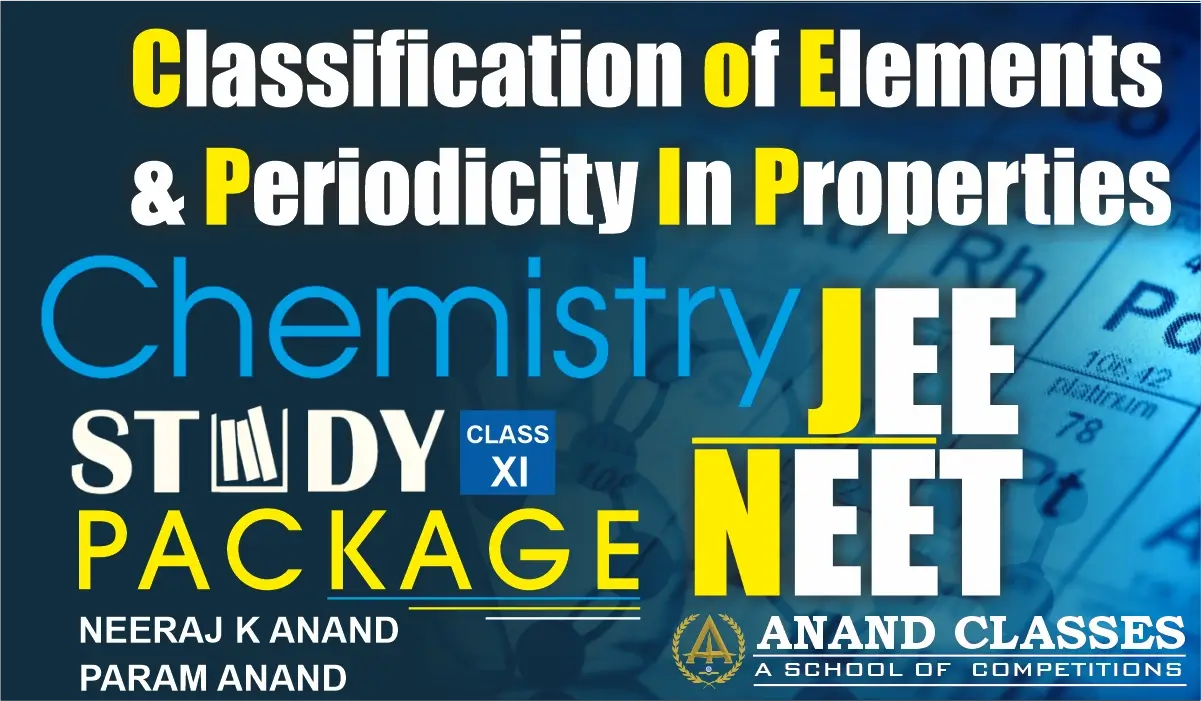Anand Classes presents a comprehensive explanation of the Modern Periodic Table, authored by Neeraj Anand and published by Anand Technical Publishers. This detailed guide is tailored for students preparing for JEE, NEET, and Class 11 CBSE Chemistry, covering the fundamental concepts of the Modern Periodic Law, the structure of the periodic table, and the classification of elements into periods, groups, and blocks. With a focus on clarity, exam relevance, and NCERT alignment, this article serves as an essential resource for mastering one of the most important topics in inorganic chemistry.
🔬 Modern Periodic Law and Modern Periodic Table
⚛️ Introduction to Modern Periodic Law
The Modern Periodic Law is an advanced concept that evolved from the limitations of Mendeleev’s periodic law. It was formulated after the work of Henry Moseley, who demonstrated a more fundamental property for the classification of elements — the atomic number.
🔍 Moseley’s Experiment and Observation
Henry Moseley conducted an experiment involving high-velocity electrons directed at metallic targets. He observed:
- The square root of the frequency (ν) of X-rays emitted is proportional to the atomic number (Z) of the element.
This relationship is mathematically represented as: $$\nu = a(Z – b)$$
Where:
- $\nu$ = Frequency of X-ray
- Z = Atomic Number (Nuclear Charge)
- a and b = Constants
📈 The plot of $\nu$ versus Z gave a straight line, indicating atomic number is a more fundamental property than atomic mass.
✅ Modern Periodic Law
“The physical and chemical properties of elements are periodic functions of their atomic numbers.”
This law forms the basis of the Modern or Long Form of the Periodic Table.
📊 Long Form of Periodic Table (Bohr’s Table)
The long form of the periodic table is designed according to the Modern Periodic Law and is also referred to as Bohr’s Table, as it reflects Bohr’s theory of electron arrangement in atoms.
Modern periodic table is also called long form of the periodic table or Bohr’s table. In this table, the elements are arranged in order of their increasing atomic number. It consists of 4 blocks (s, p, d and f), 18 groups numbered from 1 to 18 and 7 periods numbered from 1 to 7.
🔸 Structural Features of the Modern Periodic Table
The well organized and tabulated classification of elements in periods and groups, as we know it today, is called the Periodic Table.
🧪 Periods in the Modern Periodic Table
The Modern Periodic Table is divided into 7 horizontal rows, known as periods. Each period signifies a new electron shell (principal quantum number) being filled.
📘 Details of Each Period:
- 🔹 1st Period (Shortest Period)
- Elements: Hydrogen (H₁) to Helium (He₂)
- Total Elements: 2
- 🔸 Only period with 2 elements, hence the shortest.
- 🔹 2nd Period (Short Period)
- Elements: Lithium (Li₃) to Neon (Ne₁₀)
- Total Elements: 8
- Begins filling the second shell (n = 2).
- 🔹 3rd Period (Short Period)
- Elements: Sodium (Na₁₁) to Argon (Ar₁₈)
- Total Elements: 8
- Starts filling the third shell (n = 3).
- 🔹 4th Period (Long Period)
- Elements: Potassium (K₁₉) to Krypton (Kr₃₆)
- Total Elements: 18
- Involves filling of the 3d subshell.
- 🔹 5th Period (Long Period)
- Elements: Rubidium (Rb₃₇) to Xenon (Xe₅₄)
- Total Elements: 18
- Involves filling of the 4d subshell.
- 🔹 6th Period (Longest Period)
- Elements: Caesium (Cs₅₅) to Radium (Ra₈₈)
- Total Elements: 32
- Includes lanthanides (58–71).
- Fills the 4f and 5d subshells.
- 🔹 7th Period (Incomplete Period)
- Starts with Francium (Fr₈₇)
- Currently consists of 19 known elements
- Includes actinides (90–103)
- Fills the 5f and 6d subshells
- Still being explored and extended with synthetic elements.
🧠 Quick Facts
- A period defines the number of electron shells used by the atoms.
- Properties change progressively across a period.
- The length of each period increases due to additional orbitals and sub-levels being filled.
🧬 Groups in the Modern Periodic Table
The Modern Periodic Table consists of 18 vertical columns, known as groups. Each group contains elements that share similar chemical and physical properties due to having the same number of valence electrons (similar outermost electronic configuration).
📘 What is a Group?
- A group is a vertical column in the periodic table.
- Elements in the same group are often referred to as a family.
- A group is typically named after the first element in the column, but some groups have special traditional names based on their unique properties.
🔹 Special Names of Groups
Here are some groups with historically significant or widely recognized names:
- Group 1: Alkali Metals
- Includes: Li, Na, K, Rb, Cs, Fr
- Highly reactive metals, form strong bases (alkalies) with water.
- Group 2: Alkaline Earth Metals
- Includes: Be, Mg, Ca, Sr, Ba, Ra
- Less reactive than alkali metals, but still form strong bases.
- Group 15: Pnicogens
- Includes: N, P, As, Sb, Bi
- Also known as the Nitrogen family, showing varied oxidation states.
- Group 16: Chalcogens
- Includes: O, S, Se, Te, Po
- Also called the Oxygen family, form compounds like oxides and sulfides.
- Group 17: Halogens
- Includes: F, Cl, Br, I, At, Ts
- Most reactive nonmetals; form salts with metals.
- Group 18: Noble Gases (Aerogens)
- Includes: He, Ne, Ar, Kr, Xe, Rn, Og
- Inert gases with full outer shells; extremely low reactivity.
🔸 Naming of Other Groups
- All other groups (3–14) are usually named after the first element of the group.
- Example: Group 13 is often called the Boron family, and Group 14 is the Carbon family.
- These groups include transition elements, inner transition elements, and main group elements.
🧠 Quick Facts
- Groups help predict chemical reactivity, valency, and bonding behavior.
- Elements in a group show gradual changes in properties down the column.
- Group number often corresponds to the number of valence electrons (especially for s- and p-block elements).
🧱 Blocks of the Modern Periodic Table
The Modern Periodic Table is divided into four main blocks — s, p, d, and f — based on the type of atomic orbital that receives the last (valence) electron. This division helps in understanding the electronic configuration and chemical properties of elements.
🔹 1. s-Block Elements
- Includes Group 1 (Alkali Metals) and Group 2 (Alkaline Earth Metals).
- Also includes Hydrogen (H) and Helium (He).
- Valence electron enters the s-orbital.
- General electronic configuration: ns1-2
🔸 Key Features:
- Highly reactive metals.
- Soft and low melting points.
- Form strong bases with water (alkalies).
🔹 2. p-Block Elements
- Includes Groups 13 to 18.
- Valence electron enters the p-orbital.
- General electronic configuration: ns2np1-6
🔸 Key Features:
- Contains metals, nonmetals, and metalloids.
- Shows a wide range of properties and oxidation states.
- Includes halogens and noble gases.
🔹 3. d-Block Elements (Transition Elements)
- Includes Groups 3 to 12.
- Valence electron enters the d-orbital.
- General electronic configuration: (n−1)d1-10ns1-2
🔸 Key Features:
- Mostly metals with high melting and boiling points.
- Good conductors of heat and electricity.
- Exhibit variable oxidation states and form colored compounds.
🔹 4. f-Block Elements (Inner Transition Elements)
- Comprise the two horizontal rows placed separately at the bottom of the periodic table:
- Lanthanides (Atomic numbers 58–71)
- Actinides (Atomic numbers 90–103)
- Valence electron enters the f-orbital.
- General electronic configuration: (n−2)f¹–¹⁴(n−1)d⁰–¹ns²
🔸 Key Features:
- Mostly radioactive (especially actinides).
- Show similar chemical properties within the series.
- Used in nuclear reactors, lasers, and magnets.
📌 Quick Facts:
- s- and p-block elements are also called normal or representative elements.
- d-block elements are called transition elements.
- f-block elements are known as inner transition elements.
- Block classification helps in understanding the chemical behavior and bonding nature of elements.
🧠 Classification Summary:
| Block | Group Range | Type of Elements | Common Name |
|---|---|---|---|
| s | 1–2 | Reactive metals | Representative elements |
| p | 13–18 | Metals, nonmetals, metalloids | Representative elements |
| d | 3–12 | Transition metals | Transition elements |
| f | Lanthanides, Actinides | Rare earth elements | Inner transition elements |
📌 Key Takeaways
- Moseley’s work led to the replacement of atomic mass with atomic number as the basis of classification.
- The Modern Periodic Table resolves the anomalies of Mendeleev’s table.
- Group and period trends help predict element properties and chemical behavior.
❓ Frequently Asked Questions (FAQs) Based on Modern Periodic Table
1. What is the Modern Periodic Law?
The Modern Periodic Law states that “The physical and chemical properties of elements are periodic functions of their atomic numbers.” This means the properties of elements repeat at regular intervals when arranged by increasing atomic number.
2. Who gave the Modern Periodic Law and why?
Henry Moseley gave the Modern Periodic Law in 1913 after discovering that atomic number is a more fundamental property than atomic mass. His work corrected the anomalies in Mendeleev’s periodic table.
3. How many periods are there in the Modern Periodic Table?
There are seven periods (horizontal rows) in the Modern Periodic Table. Each period corresponds to the number of electron shells in the elements.
4. How many groups are present in the Modern Periodic Table?
The Modern Periodic Table has 18 vertical columns, known as groups, which classify elements with similar outermost electron configurations.
5. What are the 4 blocks in the Modern Periodic Table?
The periodic table is divided into four blocks based on the subshell being filled:
- s-block (Groups 1 and 2)
- p-block (Groups 13 to 18)
- d-block (Groups 3 to 12)
- f-block (Lanthanides and Actinides)
6. What are representative elements?
Elements of the s- and p-blocks (except noble gases and hydrogen) are called representative elements. They exhibit variable valency and typical chemical properties.
7. What are transition elements?
d-block elements (Groups 3–12) are called transition elements. They form colored compounds, have variable oxidation states, and act as good catalysts.
8. What are inner transition elements?
f-block elements (lanthanides and actinides) are called inner transition elements. They are placed separately at the bottom of the periodic table to keep it compact.
9. Which is the shortest and the longest period in the periodic table?
- The 1st period is the shortest, with only 2 elements (H and He).
- The 6th period is the longest, containing 32 elements, including lanthanides.
10. Why is the periodic table important for JEE and NEET?
The periodic table helps students predict element properties, understand periodic trends, and classify elements based on atomic structure. It forms the basis for many questions in JEE, NEET, and Class 11 Chemistry.
📚 Buy Study Material & Join Our Coaching
For premium study materials specially designed for JEE, NEET, NDA, and CBSE/ICSE Classes, visit our official study material portal:
👉 https://publishers.anandclasses.co.in/
To enroll in our offline or online coaching programs, visit our coaching center website:
👉 https://anandclasses.co.in/
📞 Call us directly at: +91-94631-38669
💬 WhatsApp Us Instantly
Need quick assistance or want to inquire about classes and materials?
📲 Click below to chat instantly on WhatsApp:
👉 Chat on WhatsApp
🎥 Watch Video Lectures
Get access to high-quality video lessons, concept explainers, and revision tips by subscribing to our official YouTube channel:
👉 Neeraj Anand Classes – YouTube Channel



